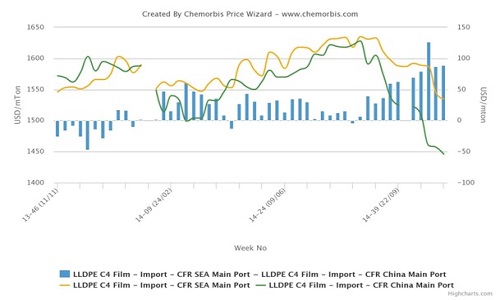PE and PP demand from Asia remained the focus for many watching the chain.
OLEFINS
Spot ethylene traded higher this week. April ethylene traded at 23.875 cpp and 24.25 cpp Monday, and several times at 25 cpp Tuesday and Wednesday. April also traded at 25.25 cpp Wednesday and traded at 25.5 cpp Thursday. No trades were heard Friday. A week earlier, spot ethylene traded at 23.5 cpp. Markets were seen this week stretching out through the first quarter of 2010, but no forward trades were confirmed aside from a 2Q strip that traded Monday at 24.25 cpp.
In the ethylene contract market, an initial agreement reached last week for March was confirmed to have been rescinded and negotiations have begun anew. April contract negotiations are also ongoing.
Refinery grade propylene traded several times this week in familiar territory. April RGP traded Monday at 21.5 cpp and at 22.75 cpp. April RGP traded again at 22.75 cpp Wednesday and a dated delivery deal was done at 23.125 cpp Wednesday. April RGP traded at 23 cpp on Thursday. No trades were heard Friday. The previous week, April RGP traded in a range of 21.125 cpp to 23.375 cpp. Gulf coast alky values were largely around 30 cpp this week. The implied price of RGP in cumene was in the 12.5-14.5 cpp range this week.
April polymer grade propylene traded at 26.68 cpp Wednesday and at 26.5 cpp Thursday. PGP traded a week earlier at 26.5 cpp. April CGP traded Thursday at 22.75 cpp, in a small-volume deal for truck delivery.
In the propylene contract market, participants confirmed settling April PGP and CGP contracts flat from March, keeping PGP at 29 cpp and CGP at 27.5 cpp.
In production news, Formosa resumed on-spec production Wednesday at its olefins 2 cracker in Point Comfort. The unit went down April 1 to repair a section of its cooling system. Shell’s GO-1 cracker remains shut and is expected to restart in mid-to-late April. Crackers at Dow’s St. Charles site and ExxonMobil’s Beaumont olefins facility are also shut, and restart dates have not been disclosed.
POLYETHYLENE
Domestic polyethylene prices were mostly steady this week, while the market’s focus remained on strong export demand and lean inventories in the US. By the end of the week, Chinese trader interest waned, traders said. Backlogs heard at Houston bagging facilities, which have been working at capacity, could limit export sales, and is already creating anxiety for some with short-dated letters of credit, traders noted.
Contract discussions for April continued. Producers are looking to implement the 5-cent increase in April that was originally sought in February and again in March. Some processors have expressed doubt this will be implemented, citing poor domestic demand. Suppliers contend that resin inventories are tight and that extraordinary export demand is pulling material away from the domestic market. So far this year, market participants have reported a 7-cent increase that was implemented between January and February, followed by an agreement to keep prices flat in March.
Buyers continue to bid for material in the spot market, both for domestic and export usage. Domestically, market participants said that processors have maintained slim inventories, and have shown interest to fill in spot needs and to some minor extent, replenish stocks. While some raised bids to be competitive in the face of stiff competition from the export market, most have not been too aggressive in their efforts to source spot material. Consequently, few larger deals are being done domestically. Producers have maintained their effort to produce material to best match orders placed ahead of the month. As demand has picked up this month, their stocks have been drained, and some have reported sold-out conditions.
Exports continue to flow to Mexico, South America and, mostly notably to China; but new deals became scarcer this week as bagging facilities in the Houston area have become full, traders said. However, the export market is continuing to drive the US PE complex, export prices are at a premium to delivered domestic railcar prices. HDPE blow mold and HDPE injection were in the low-to-mid 40s cpp range, and LLDPE film butene was in the mid 40s cpp range. LDPE film was in the high 40s cpp to low 50s cpp range.
The Plastics Exchange spot trading floor had about 2.5 million pounds of HDPE injection offered each day this week, and about 1 million pounds of LDPE film, HDPE blow mold and LLDPE film.
POLYPROPYLENE
Spot PP prices were steady this week but processors continued to hunt for material amid strong export demand pulled material away from the domestic market. Inventories throughout the supply chain are light and competition for material abounds.
April PP contracts are still under discussion. Several participants said that they expect their contract prices to remain flat this month, in line with a flat settlement for April propylene monomer. PP Producers nominated a 3-cent increase for April contracts after PP prices rose about 1 cent in March, participants said.
PP supplies, which had already been snug, continue to tighten driven by strong export demand. Domestically, processors have kept their stocks slim, and continue to bid for incremental railcars when needed. However, overall domestic demand remains weak, traders reported, and most bids have remained below the most recent transaction levels. Few higher volume spot deals were seen concluded this week in the domestic market.
The export market remained the focus this week. There has been a heavy flow of PP sent to international markets, notably China, which has pushed prices higher in the Houston area. In most cases, this market remains priced at a premium to spot domestic prices. HoPP is in the high 30s cpp to low 40s cpp range, with the high end of that range the FOB Houston warehouse price. CoPP remains at about a 1-2-cent premium.
Offers on The Plastics Exchange spot trading floor have been light, but grew towards the end of the week, when there were about had about 4 million pounds of CoPP offered and about 2.5 million pounds of HoPP made available. The increase in spot supplies have come from Houston exporters offering material back to the market.
POLYSTYRENE
Polystyrene spot prices were steady this week. GPPS was in the mid-to-high 40s cpp range. HIPS was in the low-to-mid 50s cpp range. Producers have proposed a 2 cpp increase for April 1 and 4 cpp for April 15 amid rising feedstock costs and light supplies.
The Plastics Exchange spot trading floor had about 1 million pounds of GPPS and about 500,000 pounds of HIPS offered each day this week.









